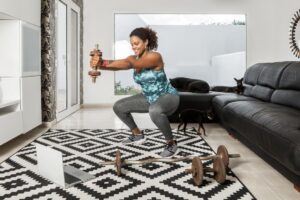Recovery is just as important as the workout itself. Whether you’re a seasoned athlete or a beginner on your fitness journey, how you recover impacts your performance, health, and motivation in the long run. In fact, experts emphasize that no one can function optimally without adequate recovery, noting that recovery can be “almost as important as the actual training… because if you’re not recovering from training, you’re not getting a boost from it.”uchealth.org This article will explore post-workout recovery strategies, mental and emotional rejuvenation, holistic wellness routines, and cutting-edge tools – all aimed at helping you bounce back stronger. Let’s dive into how you can nurture your body and mind between workouts for maximum wellness and performance.
Why Recovery Matters
When you exercise, you challenge your body and create tiny stresses (like microscopic muscle tears). Actual improvements happen during rest, as muscles repair and come back stronger. Skipping recovery not only stalls your progress but also increases the risk of injury and burnout. Additionally, life’s daily stresses (work, school, etc.) compound with training stress. If you’re constantly in a high-stress, high-cortisol state, your body stays in “fight or flight” mode and can’t properly heal uchealth.org. That’s why smart recovery practices are essential for everyone who’s active, from competitive athletes to casual gym-goers. By prioritizing recovery, you’ll not only feel better – you’ll perform better and stay healthier over the long term uchealth.org.
Post-Workout Recovery Strategies
After a tough workout, what you do in the next minutes and hours can dramatically affect how you feel and progress. Here are some post-workout recovery strategies to incorporate:
- Hydration and Nutrition: Replenishing fluids and nutrients is job one after exercise. Sweating can deplete you, so drink water and consider electrolytes to restore balance. Staying well-hydrated helps boost blood flow to muscles, reducing pain and flushing out waste byproducts that contribute to soreness. Likewise, fuel up with quality nutrition: consuming carbohydrates and protein soon after exercise helps replenish muscle glycogen and kick-start muscle repair. For example, eating some carbs with a bit of protein within the first hour post-workout can speed up recovery for your next training. Don’t neglect overall healthy eating throughout the day – your body needs the right building blocks to recover.
- Active Recovery & Stretching: Rather than collapsing on the couch immediately, try gentle movement to cool down. Light activities like a slow walk or dynamic stretching help circulation and deliver nutrients to tired muscles uchealth.org. Research shows that doing a low-intensity cool-down (active recovery) can assist performance and waste removal from muscles. Dynamic stretching (moving stretches that take joints through their range of motion) prior to or after exercise can also reduce injury risk and improve muscle recovery by increasing blood flow. If you enjoy them, foam rolling or gentle static stretches can ease tight spots – while studies find mixed results on performance, many people feel less sore afterward. The key is to keep your body moving lightly to “reset” after intense effort.
- Rest Days and Quality Sleep: Remember that improvements happen when you rest – so schedule regular rest days in your week. Taking at least one full day off from intense exercise each week gives your muscles, joints, and nervous system time to repair. Some athletes even follow periodization cycles (e.g. 3 weeks of training, 1 week lighter) to boost performance and reduce injury risk. Sleep, meanwhile, is the ultimate recovery tool. During deep sleep, your body is hard at work repairing muscle tissue and releasing hormones like growth hormone that spur healing uchealth.org. In fact, sleep is so critical that lack of it is linked to decreased endurance, poorer performance, hormone imbalances (higher cortisol, lower recovery hormones), and increased injury risk. Aim for 7–9 hours of sleep (or whatever amount leaves you feeling refreshed) and practice good sleep hygiene (a dark, cool room, no screens before bed) to maximize recovery benefits. As one sports physician put it, “Sleep is super-important” because most muscle repair and growth happens during sleep.
- Refuel and Rehydrate (Again): Recovery isn’t over when the soreness fades. Continue to listen to your body’s needs throughout the day. Keep sipping water and eating balanced meals with proteins, healthy carbs, and fats to aid ongoing repair. Proper daily nutrition and hydration maintain the body’s healing processes and prepare you for the next workout. By consistently meeting your body’s needs, you’ll recover faster and come back stronger.
Mental and Emotional Recovery
Recovery isn’t just physical – your mind needs downtime too. Intense training and competitions can be mentally draining, and life stress can weigh on you. Mental and emotional recovery strategies will help you stay balanced, motivated, and resilient:
- Mindfulness and Relaxation: High stress levels can hinder your body’s ability to recover, so it’s important to actively manage stress. Techniques like mindfulness meditation, deep breathing, or progressive muscle relaxation can shift you into “rest and digest” mode. Studies show that chronic stress, if unmanaged, leads to underperformance and even increases injury risk and burnout. On the flip side, practicing relaxation or meditation has been linked to lower injury rates and better recovery. In one college sports study, a guided relaxation program cut injury rates by over 50%! Another program found that mindfulness training had a positive impact on athletes’ recovery, focus, and performance while reducing burnout. Even just 5-10 minutes a day of meditation or breathwork can calm your nervous system and help your mind and body recharge centerfoundation.org. Pro Tip: Try using a meditation app or breathing exercise after a tough workout or before bed to speed up mental recovery.
- Active Mental Detachment: Just as your muscles need time off, so does your brain. Give yourself permission to step away from the grind occasionally. That means mentally detaching from training – for example, taking an evening to enjoy a hobby, time with friends/family, or simply relax without thinking about your sport. Elite coaches call this active mental detachment, and it’s a powerful way to prevent burnout. Engaging in unrelated activities helps reset your mind and reduce the performance pressure simmering in your head. When you return to training, you’ll feel mentally fresher and more focused. Similarly, practicing post-performance reflection in a healthy way can aid emotional recovery: write in a journal or talk with a coach about what went well and what to improve, then let it go thementalgame.me. This structured reflection provides closure so you’re not endlessly rehashing mistakes, helping you learn and move on with a positive mindset. Remember, mental fitness is part of overall fitness – a resilient, clear mind will boost your physical performance too.
- Emotional Support and Balance: Human connection and a balanced identity are important for emotional wellness. Make time to socialize and have fun outside of training – it reminds you that you’re more than just an athlete. Talking with friends, family, or teammates about non-sport topics can lighten your mood and relieve stress. Also, set boundaries to protect your mental health: for instance, avoid obsessively checking workout stats 24/7 or ruminating on competition results at all hours, thementalgame.me. By “turning off” the athlete mindset now and then and nurturing other parts of your life, you’ll protect your passion for training and avoid mental exhaustion. The goal is a healthy mind-body balance – when you feel recharged mentally, you’re more motivated and ready to tackle the next challenge.
Holistic Wellness Routines
“Holistic wellness” means looking at the big picture of your health – integrating physical, mental, and even emotional/spiritual practices into your daily life. For sustainable fitness and recovery, it helps to establish daily routines that nourish all aspects of you:
- Mind-Body Balance: Recognize that your overall well-being is influenced by many factors working together. A holistic routine might include regular physical activity (strength training, cardio, or even a brisk walk or yoga session) to keep your body strong, mental practices like meditation or journaling for stress relief, and adequate rest for recovery. This well-rounded approach ensures you’re caring for your body, mind, and spirit in harmony. For example, adding a gentle yoga or stretching session on rest days can improve flexibility and provide a meditative, calming experience – hitting both physical and mental recovery in one go.
- Consistent Healthy Habits: Small daily habits compound into big wellness benefits. Focus on the fundamentals: eat nutritious whole foods, stay hydrated, get consistent sleep, and listen to your body’s signals. Listening to your body means noticing when you need a break or when something causes pain and responding with care (like taking an extra rest day or doing mobility work). Build routines that work for you – maybe a morning routine of hydrating and stretching, a midday walk to destress, or an evening wind-down with light stretching and reading to prepare for sleep. Holistic wellness is very personal and not one-size-fits-all, so find what makes you feel balanced and energized. Remember: adopting a holistic lifestyle is a journey of progress, not perfection. Start with small, manageable changes – like adding one new recovery habit this week – and gradually create a routine that supports your entire well-being.
- Benefits of a Holistic Approach: When you take care of all dimensions of health, you’ll likely notice improvements in how you feel day-to-day. People who embrace a holistic wellness routine often report higher energy levels, better mental clarity, less stress, and a happier mood. Over time, this approach can also strengthen your immune system and reduce the risk of illness, since you’re giving your body comprehensive care sportsandwellnessdoc.com. For athletes and fitness enthusiasts, holistic wellness means fewer burnout days and more capacity to stay active for years to come. The balanced lifestyle will make you more resilient to setbacks and help you enjoy fitness as a lifelong journey rather than a short-term push.
Technology and Tools for Enhanced Recovery
Modern recovery isn’t just about foam rollers and ice packs – a variety of high-tech tools and techniques can give you an extra edge in healing and rejuvenation. From gadgets to cold therapy, here are a few popular recovery aids (and what science says about them):
- Percussive Massage Guns: These handheld devices (like Theragun and others) use rapid vibrations to massage your muscles. The gentle hammering action increases blood flow to targeted areas and can loosen up tight knots. When used properly, massage guns can relieve muscle soreness and stiffness and even improve your flexibility and range of motion pmc.ncbi.nlm.nih.gov. A 2023 systematic review concluded that percussive therapy “can help improve acute muscle strength, explosive power, and flexibility, and reduce muscle pain.” In plain terms, they’re a convenient way to get some of the benefits of a professional massage at home. While massage guns haven’t been proven to directly increase endurance or long-term performance, they do help you feel better faster by reducing soreness and perceived fatigue health.clevelandclinic.org which can indirectly benefit your training. Use them on major muscle groups for a minute or two post-workout or as part of your warm-up. (Just avoid bony areas and sensitive spots.) If you don’t have a massage gun, traditional self-massage or foam rolling can offer similar circulation-boosting benefits.
- Cold Water Immersion (Ice Baths): Plunging into an icy bath might sound extreme, but many athletes swear by it. Cold-water immersion therapy involves submerging your body in cold water (around 50°F or 10°C) for a few minutes. Research indicates that icy water can indeed aid post-exercise recovery by reducing inflammation and muscle soreness. The cold causes blood vessels to constrict, which may help flush out metabolic waste; when you re-warm, fresh blood rushes back to muscles, potentially speeding recovery. Studies have found that cold plunges reduce exercise-induced muscle damage, leading to less soreness and better physical function the next day. Athletes also report that regular cold exposure builds mental resilience and even boosts mood and energy, mayoclinichealthsystem.org. However, moderation is key – daily ice baths right after every workout could blunt some long-term muscle gains (since inflammation, in small doses, helps muscles adapt). So, use cold plunges strategically: they’re great after competitions or very hard workouts to tame soreness, but you might skip them after light training sessions. Always start slow (even 30 seconds can be a shock at first!) and consult a doctor if you have any cardiovascular concerns. If a fancy cold tub isn’t accessible, a simple home ice bath or even a cold shower can provide similar perks.
- Sleep Tracking Wearables: In the age of smart technology, tracking your recovery has never been easier. Wearable devices and apps (think fitness watches, WHOOP**, Oura Ring, etc.) can monitor your sleep quality, heart rate variability (HRV), and other metrics that reflect recovery. Since sleep is so crucial for muscle repair and mental refresh, these tools help ensure you’re getting enough restorative sleep each night. Many athletes use sleep trackers to see how long they slept, how deep their sleep was, and how recovered they are feeling in the morning. This data can be eye-opening – for example, you might discover your sleep drops on stressful days or that you need a stricter bedtime. By increasing your awareness, sleep tracking can provide feedback that motivates you to improve your habits (earlier bedtime, less screen time late at night, etc.), sportsmith.co. There’s solid evidence that improving sleep leads to better athletic performance, so treating sleep as an important “stat” to optimize makes sense. That said, don’t obsess over the numbers – use them as a guide. The goal is to wake up feeling refreshed and ready, and a tracker is just one tool to help you get there. In addition to sleep, some wearables monitor stress levels, recovery scores, and even suggest if you should push hard or take it easy on a given day based on your vitals. This kind of insight can be especially helpful for balancing training and rest, preventing overtraining, and making recovery an integral part of your fitness routine.
(WHOOP is a popular fitness band known for focusing on recovery scores and HRV.)
Embrace Recovery for Long-Term Success
In the quest for fitness, remember that progress happens during recovery. By applying these strategies – from proper post-workout care and mental downtime to holistic healthy living and smart tech – you’re setting yourself up to perform at your best and feel great doing it. The key is finding a recovery routine that motivates and rejuvenates you, so you stay consistent. Listen to your body, be patient with yourself, and celebrate rest as an active part of your training plan. Whether you’re pushing for a new personal record or simply staying in shape, prioritizing recovery and wellness will keep you in the game for the long haul. So next time you finish a workout, think of recovery not as an afterthought, but as the essential final rep that makes all the difference! Here’s to a healthier, stronger, and more balanced you.





